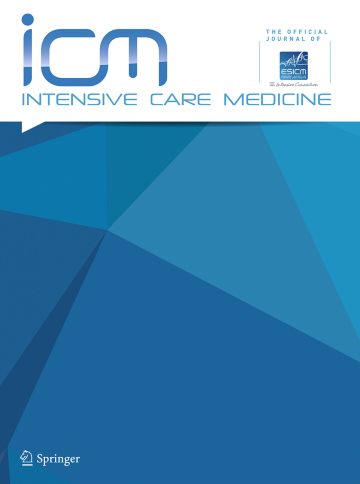Hemodynamic and neurological presentations of invasive meningococcal disease in adults: a nationwide study across 100+ French ICUs : The RETRO-MENINGO study.
IF 21.2
1区 医学
Q1 CRITICAL CARE MEDICINE
引用次数: 0
Abstract
PURPOSE Invasive meningococcal disease (IMD) is a rare but potentially fatal infection caused by Neisseria meningitidis. In adults requiring admission to intensive care unit (ICU), IMD typically presents with two distinct clinical presentations: neurological (meningitis) and hemodynamic (sepsis). These presentations are often conflated, despite the differences in pathophysiology and outcome. METHODS RETRO-MENINGO is a nationwide, multicentre, retrospective cohort study conducted in 102 French ICUs between January 1, 2016, and December 31, 2024. Adults (≥ 18 years) admitted to the ICU with a microbiologically confirmed IMD were categorised as having either a neurological or a hemodynamic presentation according to the main reason for ICU admission. The primary outcome was day-60 mortality in each presentation. RESULTS Of 654 patients (median age 33 years [IQR 21-56]; 63.5% without comorbidities), 407 (62%) had a neurological and 247 (38%) a hemodynamic presentation at ICU admission. Hemodynamic presentation was associated with older age (39.0 vs. 30.0 years; p = 0.001), immunosuppression (17.0% vs. 7.1%; p < 0.001), purpuric rash (55.9% vs. 43.7%; p = 0.003), earlier ICU admission (1 vs. 2 days; p = 0.001) and more frequent bacteremia (83.8% vs. 35.6%; p < 0.001). Serogroup B was predominant in neurological presentation, whereas serogroup W135 was more common in hemodynamic presentation. Compared to neurological presentation, hemodynamic presentation required more organ support (vasopressors, invasive mechanical ventilation, transfusions, renal replacement therapy) and had a significantly higher day-60 mortality (25.5% vs. 4.7%; p < 0.001). Hemodynamic presentation (aOR 4.33, 95% CI 2.26-8.62; p < 0.001), absence of comorbidities (aOR 2.21, 95% CI 1.19-4.23; p = 0.014), age > 35 years (aOR 3.65, 95% CI 1.73-6.07; p < 0.001), arterial lactate level > 5 mmol/L (aOR 2.60, 95% CI 1.43-4.77; p = 0.002) and symptom onset < 24 h (aOR 1.90, 95% CI 1.00-3.55; p = 0.040) were independently associated with day-60 mortality, while early administration of a parenteral third-generation cephalosporin prior to ICU admission was strongly protective (aOR 0.31, 95% CI 0.18-0.55; p < 0.001). CONCLUSION Neurological and hemodynamic presentation of IMD are clinically and prognostically distinct. Recognition of these phenotypes is critical for appropriate management and prediction of outcome.成人侵袭性脑膜炎球菌病的血液动力学和神经学表现:一项覆盖100多个法国icu的全国性研究:retroo - meningo研究
目的:侵袭性脑膜炎球菌病(IMD)是由脑膜炎奈瑟菌引起的一种罕见但可能致命的感染。在需要入住重症监护病房(ICU)的成人中,IMD通常表现为两种不同的临床表现:神经学(脑膜炎)和血流动力学(败血症)。尽管在病理生理和结果上存在差异,但这些表现经常被混为一谈。方法retroo - meningo是一项全国性、多中心、回顾性队列研究,于2016年1月1日至2024年12月31日在102名法国icu中进行。根据进入ICU的主要原因,因微生物学证实的IMD入住ICU的成人(≥18岁)分为神经学表现或血流动力学表现。主要终点为每次就诊的第60天死亡率。结果654例患者中位年龄33岁[IQR 21-56];63.5%无合并症),407例(62%)在ICU入院时出现神经学症状,247例(38%)出现血流动力学症状。血流动力学表现与年龄较大相关(39.0岁vs 30.0岁;P = 0.001),免疫抑制(17.0% vs. 7.1%;p 35岁(aOR 3.65, 95% CI 1.73-6.07;p 5 mmol/L (aOR 2.60, 95% CI 1.43 ~ 4.77;p = 0.002)且症状发作< 24 h (aOR 1.90, 95% CI 1.00-3.55;p = 0.040)与第60天死亡率独立相关,而在ICU入院前早期给予第三代头孢菌素肠外注射具有很强的保护作用(aOR 0.31, 95% CI 0.18-0.55;p < 0.001)。结论IMD的神经学和血流动力学表现在临床和预后上是不同的。识别这些表型对于适当的管理和预测结果至关重要。
本文章由计算机程序翻译,如有差异,请以英文原文为准。
求助全文
约1分钟内获得全文
求助全文
来源期刊

Intensive Care Medicine
医学-危重病医学
CiteScore
51.50
自引率
2.80%
发文量
326
审稿时长
1 months
期刊介绍:
Intensive Care Medicine is the premier publication platform fostering the communication and exchange of cutting-edge research and ideas within the field of intensive care medicine on a comprehensive scale. Catering to professionals involved in intensive medical care, including intensivists, medical specialists, nurses, and other healthcare professionals, ICM stands as the official journal of The European Society of Intensive Care Medicine. ICM is dedicated to advancing the understanding and practice of intensive care medicine among professionals in Europe and beyond. The journal provides a robust platform for disseminating current research findings and innovative ideas in intensive care medicine. Content published in Intensive Care Medicine encompasses a wide range, including review articles, original research papers, letters, reviews, debates, and more.
 求助内容:
求助内容: 应助结果提醒方式:
应助结果提醒方式:


